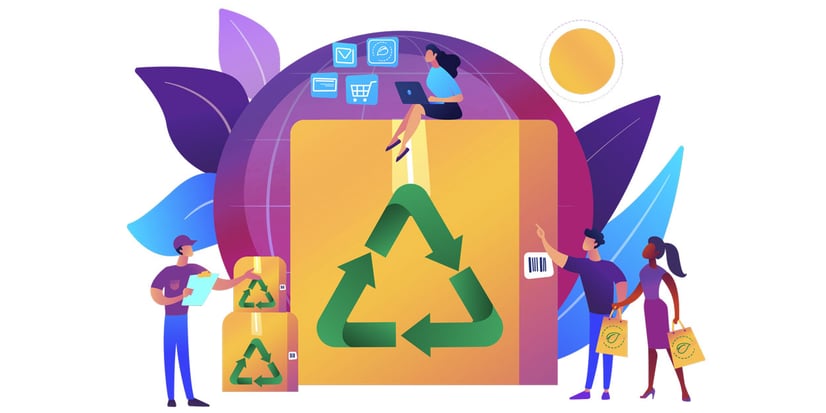
What’s better for the environment: buying online or in-store? Well, it depends. One truck delivering 100 packages is generally far more efficient than 100 individuals taking separate car journeys to the store. But the equation quickly changes when you consider next- and same-day delivery, missed delivery attempts, and buying with the intention of returning much of the order. Factors that were once a competitive edge for online – such as cheaper goods, fast shipping, and unlimited returns – are now being called out for their damaging environmental impact.
Consumers are starting to pay attention. One survey by packaging company Mondi found that over half of consumers would switch to a different brand that uses less packaging. And two in three shoppers are willing to wait longer for online deliveries if it results in lower carbon emissions, according to a survey by eCommerce shipping platform Sendcloud.
As more consumers than ever intend to change their consumption habits to reduce their impact on the planet, it pays to ensure your eCommerce business aligns with their sustainability values. Here are five ideas to get you started…
1. Use eco-friendly packaging
Amazon has consistently been ranked one of the worst offenders for excess packaging, but it’s a widespread problem across the industry. According to a poll by the Chartered Institute of Marketing, over 85% of consumers believe that companies use too much packaging. It’s leading to online retailers exploring plastic-free solutions, switching to cardboard packaging or even recyclable and biodegradable packing solutions.
Samsung brought out a range of eco-packaging for its TVs. The packages are made from corrugated cardboard, which makes for easier recycling. But as reuse is better than recycling for the environment, Samsung also applied a dot matrix design on each side of its cardboard boxes, allowing customers to cut the boxes easily and assemble them into various household items, such as shelves, magazine racks and pet houses.
2. Explore green delivery options
Speedy fulfillment and distribution are now a critical element in every online shopping experience. If retailers and logistics companies want to keep up, they need to develop new, more sustainable delivery solutions that allow them to handle increasing parcel volumes while reducing their environmental and cost impact.
Often, when consumers order multiple items in one go, each item may be sent in separate shipments from different warehouses and arrive at different times. To get around this, online retailers are now giving customers the option to hold shipments for longer and send everything in one package, or even opt for slow, more environmental shipping options. According to the MIT Center for Transportation and Logistics, customers who opt for standard home delivery over faster options could help decrease carbon dioxide emissions by about 30% in the last mile of a delivery.
Another way to balance some of the environmental downsides of delivery is purchasing carbon offsets. Craft marketplace Etsy was one of the first global eCommerce companies to completely offset the greenhouse gas emissions produced by its sellers shipping products, for example. Businesses can either invest in offsets themselves, or allow their customers to pay an optional offset fee at the checkout.
3. Stock sustainable products and brands
Consumers aren’t just focused on having their purchases fulfilled in a more environmentally friendly way; they want to buy more sustainable products, too. More and more retail businesses are now founded on sustainable principles, for example selling upcycled products or items produced with a sustainable use of resources. At the same time, traditional retailers like Zara and H&M are also trying to make the transition, for example introducing sustainable product ranges and “return, repair and recycle” programs to close the loop, promote longevity over speed of use, and reduce waste. Online marketplaces are also taking a step in the sustainable direction, doing more to work with eco-friendly and green brands and bringing them to their customers’ attention with special tags and eco-friendly categories.
4. Reduce waste
In a world of fast fashion and limitless consumerism, retailers have felt the pressure to overproduce, which has led to more stock ending up in landfill. But we’re now seeing a shift towards a preference for more considered retail. French slow fashion brand Sézane is renowned for its timeless pieces and brings out a seasonal collection four times a year, complemented by smaller curated capsule collections. Global online fashion retailer ASOS launched a small circular collection, featuring trend-led clothing and accessories, all designed and made to meet circularity principles. Each product in the collection is designed to remain in use for as long as possible, can be re-used or re-purposed at the end of its life, and creates minimal waste.
Others are using technology to order the right amounts in the first place and minimize the risk of overstocks. AI-powered forecasting and business intelligence tools can help companies understand how much they should order (or produce) for each product, category, and product group. These tools take into consideration internal information, like historical sales and consumer habits, as well as external information such as macro-trends, the effect of holidays, weather patterns, and so on. Retailers can use this intelligence to reduce not only costs, but also overproduction and waste.
5. Limit the chances of returns
Retailers have made the returns process so easy and low cost that it’s now common for customers to buy multiple products with the intention of sending most of them back. In fact, Barclaycard research found that over a third of shoppers deliberately over-purchase and subsequently return unwanted items, with many ordering multiple versions of the same item so they can make their mind up on what to keep once they products are delivered. To combat this, some retailers are taking measures to proactively discourage customers from bracketing. Zara, for example, now charges customers to return items purchased online by mail, although they can still return them to store for free.
But not all returns are the consequence of excessive buying. According to research by Shopify Plus, wrong size, fit, and style are the cause of 72% of returns in fashion product categories. To reduce these kinds of returns, retailers are working on improving online size guidelines, adding more detailed product descriptions, and using technologies such as augmented reality to help customers visualize exactly how products will look before committing to a purchase.
What if customers still need to make a return? Some companies are exploring ways to make that reverse supply chain as environmentally friendly as possible. In the US, for example, package-free return drop-off programs like Happy Returns are becoming more popular. Customers drop off their unwanted items at a returns bar without labels or packaging. All items are then aggregated in reusable totes and shipped to regional return hubs for sorting and processing, saving retailers up to 40% in shipping costs and reducing greenhouse gas emissions by 120,000 pounds for every million returns.
Enabling positive change
While not all these suggestions may make sense for your own online business, small but meaningful changes can have a real impact. By focusing on sustainability across your company and exploring new ways of protecting the environment – whether that’s by partnering with green logistics companies or setting up a new recycling scheme – not only can you attract sustainably minded customers - you can also help to build a better future.
If you would like to get more information on how LS Retail’s intelligent analytics and demand planning software can help you optimize your replenishment, contact us.

